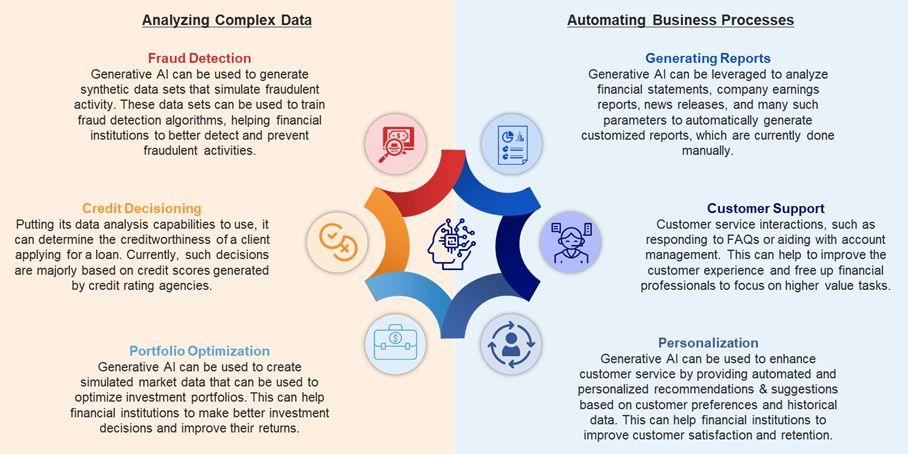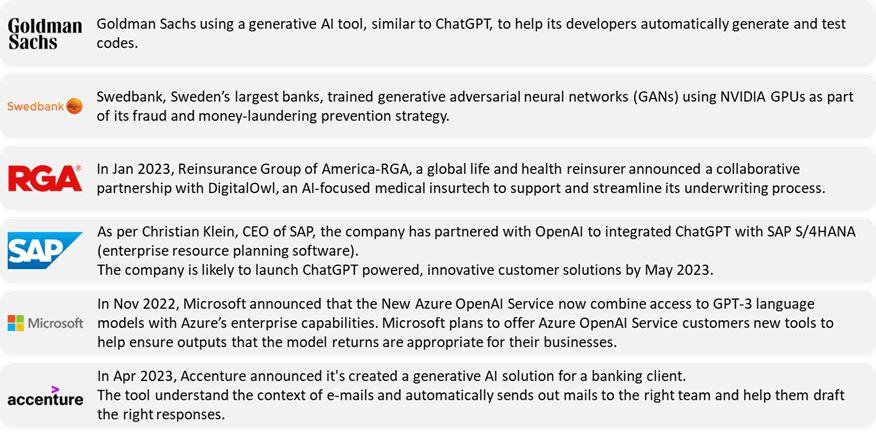Can ChatGPT Disrupt Financial Services?
Published on 12 May, 2023

Generative artificial intelligence (AI) tools, including ChatGPT, have led to increased adoption of AI in financial advisory and risk management. These tools have the potential to address issues related to operational inefficiencies, fraudulent activities, and the need for personalized services. However, it is important to recognize that ChatGPT has limitations, and human intelligence and judgment will continue to be crucial for decision-making.
ChatGPT, the generative AI tool launched in 2022 became a hot discussion topic and swiftly attracted over 100 million active users within two months, surpassing the popular social media platforms like TikTok and Instagram. ChatGPT distinguishes itself from other AI models on account of its inherent functionality and capabilities. Powered by sophisticated algorithms, ChatGPT is programmed to analyze substantial amounts of data to respond in a natural and engaging manner.
ChatGPT can be leveraged across various business functions and perform tasks, such as language translation, complex data analysis, text summarization, and conversation generation, within few seconds. Similar to how the internet revolutionized various industries in the 90s, ChatGPT holds the potential to transform numerous business functions across industries mainly by automating key processes that typically require human intervention.
Utilization of AI in financial services sector
AI services generate USD ~20 billion in revenue globally with financial services accounting for 67% of total revenue. This is expected to grow 20–30% annually through 2032, driven by the rising consumer demand for digitization of banking services, increasing scope and capabilities of FinTech, and growing impetus of BFSI firms to improve customer experience.
Currently, the financial services industry relies heavily on AI to provide customer service (chatbots, virtual assistants, etc.) and manage back-office operations (credit and risk underwriting, asset management, etc.). However, the advent of generative AI is expected to drive adoption of AI in financial advisory and risk management. Currently, 25–30% of the revenue generated by AI services comes from the financial services sector.
The financial sector plays a crucial role in the global economy, facilitating the flow of capital and providing vital services such as lending, investing, and insurance. Like others, the financial services sector is also not immune to challenges that can have far-reaching consequences for individuals, businesses, and the broader economy. From regulatory compliance and cybersecurity threats to financial misconduct and systemic risks, the financial services sector persistently faces new challenges that require innovative solutions and effective management. Understanding these issues and their implications is vital for adequate functioning of the financial sector and global economy.
Key Issues Currently Faced by Financial Services Sector
- High operational inefficiencies: Presently, numerous tasks, typically resolving customer queries, cross-checking and processing documents, monitoring ongoing transactions, and data entry, in the financial services industry are performed manually. These manual processes often result in high costs and build inefficiencies in decision-making. Additionally, certain tasks such as analyzing and summarizing complex financial statements, press releases, earnings reports, and corporate announcements are time-consuming. This can impact the functioning of investment firms, such as Private Equity and Venture Capital firms, as inefficiencies and delay in delivery of synthesized data can result in missed investment opportunities.
- High risk of fraudulent activities: The expansion of the financial services industry is closely linked to the proliferation of financial instruments, such as banking transactions (loan approval and disbursement, deposits, and withdrawals) and issuance of insurance policies. This upsurge has resulted in large volumes of data being generated daily, which require increased capabilities to process the data. Manual processing of high-volume data is more prone to overlooking fraudulent activities and non-compliance with regulatory requirements.
- Personalization of services: Financial services is a highly competitive market necessitating service providers to evolve and develop a personal connect with customers through customized offerings to fulfil their unique financial needs and retain customers. Furthermore, customer profiles evolve rapidly, requiring companies to swiftly develop tailored financial products that reflect real-time changes in the customer's profile, such as credit history, income, and transaction patterns.
How ChatGPT can overcome the issues
The major use cases of ChatGPT-like generative AI in the financial services sector can be classified into two categories:

Financial service providers are placing significant bets on the implementation of ChatGPT or other similar generative AI tools due to their diverse range of applications. Below are a few examples of how generative AI is used in real-world scenarios within the financial services industry.

Impact of ChatGPT on the Financial Services Sector
- Shift of entry-level job profiles to more value-add tasks: While generative AI provides information, the decision-making would still be reliant on human intelligence and judgment. On average, 40–50% of a US bank workforce engages in administrative services. With the increased adoption of generative AI tools like ChatGPT, a considerable amount of this workforce is expected to be released for more value-adding jobs like financial analysis, business development, up-selling, and cross-selling, among others.
- Efficient fraud detection: The ability to forecast aberrations in data patterns can enhance the efficacy of fraud detection, leading to reduced expenses associated with loan fraud and subsequently lower non-performing assets (NPAs). Insurance companies, akin to banks and financial service firms, can harness data analysis capabilities to identify fraudulent claims.
- High reliance on information technology (IT): Deployment of ChatGPT-like systems would result in the increased usage of IT in the financial services sector, consequently increasing tech-based jobs in the sector, as there would be additional avenues related to updating and maintaining the IT infrastructure for generative AI and the allied systems.
- Rapid personalization: Dynamic and more exclusive personalization of offerings to a particular customer/set of customers would aid in increased customer satisfaction, in a cost-efficient manner.
Limitations of ChatGPT
While ChatGPT can provide valuable insights and assist with certain tasks, it is important to note that there are limitations to its capabilities.
- Accuracy: ChatGPT's responses are generated through machine learning algorithms, which may produce incomplete or biased outputs based on the quality of the data used to train the model. Additionally, ChatGPT’s lack of transparency regarding its sources and methodology can also contribute to raise concerns; it may be challenging to evaluate the quality and reliability of its responses without this information.
- Privacy concerns: ChatGPT generates recommendations by analyzing data it collects from users, including personal information like demographic data, search history, and spending patterns. As a result, concerns regarding the privacy of user data can present a significant obstacle to increase adoption in heavily regulated industries like financial services, where adherence to data privacy regulations is a key requirement.
- Data Bias: ChatGPT and other generative AI tools learn from the data on which they are trained. This means that if the training data is biased or inaccurate, it may be reflected in the tool’s responses. As a result, it is critical to be aware of these potential biases and limitations when using generative AI tools.
Conclusion
ChatGPT has the potential to revolutionize the financial services sector, helping businesses make informed decisions and improve customer experiences. However, appropriate measures are required to counter bias and inaccuracy. The users are advised to evaluate data privacy regulations and verify the output from alternative sources.

